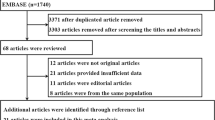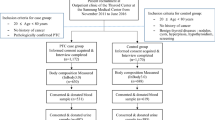Abstract
Background/Objectives
Experimental and clinical studies have shown that vitamins A and E can inhibit cancer formation and progression. The unfavourable status of these vitamins can represent risk factors for the disease. This study aimed to evaluate the associations between the nutritional status of vitamins A and E (serum levels and dietary intake) and histopathological outcomes in Papillary Thyroid Carcinoma (PTC) patients.
Subjects/Methods
We applied a cross-sectional study (2017–2018) and quantified retinol (ROH) and α-tocopherol (TOH) serum levels and vitamins dietary intake of 46 PTC patients. Serum vitamins were quantified by high efficiency liquid chromatography and vitamins dietary intake was analyzed by 24‐hr dietary recalls.
Results
Patients with lower ROH serum levels were more likely to present lymph node metastasis and/or angiolymphatic invasion (p = 0.025). In addition, higher vitamin A and vitamin E intake are related to the absence of extrathyroidal extension (p = 0.013) and lymph node metastasis (p = 0.007), respectively. Our findings suggest that a ROH serum level greater than 2.65 μmol/L in PTC patients may be a protective factor against the presence of lymph node metastasis and angiolymphatic invasion. In addition, vitamin A and E intake may protect against extrathyroidal extension and lymph node metastasis.
Conclusions
A favourable nutritional status (higher serum levels and/or intake) of vitamin A and E may be associated with less aggressive tumours in PTC patients.
This is a preview of subscription content, access via your institution
Access options
Subscribe to this journal
Receive 12 print issues and online access
$259.00 per year
only $21.58 per issue
Buy this article
- Purchase on Springer Link
- Instant access to full article PDF
Prices may be subject to local taxes which are calculated during checkout





Similar content being viewed by others
References
Ferlay J, Ervik M, Lam F, Colombet M, Mery L, Pineros M, et al. Cancer Today (powered by GLOBOCAN 2018). IARC CancerBase; 2018.
Boufraqech M, Patel D, Xiong Y, Kebebew E. Diagnosis of thyroid cancer: state of art. Expert Opin Med Diagn. 2013;7:331–42.
Gou Q, Gao L, Nie X, Pu W, Zhu J, Wang Y, et al. Long noncoding RNA AB074169 inhibits cell proliferation via modulation of KHSRP-mediated CDKN1a expression in papillary thyroid carcinoma. Cancer Res. 2018;78:4163–74.
Maksimovic S, Jakovljevic B, Gojkovic Z. Lymph node metastases papillary thyroid carcinoma and their importance in recurrence of disease. Med Arch (Sarajevo, Bosnia Herzeg). 2018;72:108–11.
Sun Y, Lv H, Zhang S, Bai Y, Shi B. Gender-specific risk of central compartment lymph node metastasis in papillary thyroid carcinoma. Int J Endocrinol. 2018;2018:6710326.
Macejová D, Galbavý S, Podoba J, Bialešová L, Brtko J. mRNA expression pattern of retinoic acid and retinoid X nuclear receptor subtypes in human thyroid papillary carcinoma. Oncol Rep. 2013;30:2371–8.
Emami A, Nazem MR, Shekarriz R, Hedayati M. Micronutrient status (calcium, zinc, vitamins D and E) in patients with medullary thyroid carcinoma: a cross-sectional study. Nutrition. 2017;41:86–9.
Lawal AO, Kolude B, Adeyemi BF, Lawoyin JO, Akang EE. Serum antioxidant vitamins and the risk of oral cancer in patients seen at a tertiary institution in Nigeria. Niger J Clin Pr. 2012;15:30–3.
Lima L, de Melo TCT, Marques D, de Araújo JNG, Leite ISF, Alves CX, et al. Modulation of all-trans retinoic acid-induced MiRNA expression in neoplastic cell lines: a systematic review. BMC Cancer. 2019;19:866.
Mamede AC, Tavares SD, Abrantes AM, Trindade J, Maia JM, Botelho MF. The role of vitamins in cancer: a review. Nutr Cancer. 2011;63:479–94.
Nash SH, Till C, Song X, Lucia MS, Parnes HL, Thompson IM Jr, et al. Serum retinol and carotenoid concentrations and prostate cancer risk: results from the prostate cancer prevention trial. Cancer Epidemiol Biomark Prev. 2015;24:1507–15.
Huang J, Panagiotou OA, Anic GM, Mondul AM, Liao LM, Derkach A, et al. Metabolomic profiling of serum retinol in the alpha-tocopherol, beta-carotene cancer prevention (ATBC) study. Sci Rep. 2017;7:10601.
Mondul AM, Watters JL, Männistö S, Weinstein SJ, Snyder K, Virtamo J, et al. Serum retinol and risk of prostate cancer. Am J Epidemiol. 2011;173:813–21.
Larouche D, Hanna M, Chang S-L, Jacob S, Têtu B, Diorio C. Evaluation of antioxidant intakes in relation to inflammatory markers expression within the normal breast tissue of breast cancer patients. Integr Cancer Ther. 2017;16:485–95.
Oh SW, Moon S, Park DJ, Cho BY, Jung KC, Lee DS, et al. Combined therapy with 131I and retinoic acid in Korean patients with radioiodine-refractory papillary thyroid cancer. Eur J Nucl Med Mol Imaging. 2011;38:1798–805.
Sailo BL, Banik K, Padmavathi G, Javadi M, Bordoloi D, Kunnumakkara AB. Tocotrienols: the promising analogues of vitamin E for cancer therapeutics. Pharm Res. 2018;130:259–72.
Sato C, Kaneko S, Sato A, Virgona N, Namiki K, Yano T. Combination effect of δ-Tocotrienol and γ-Tocopherol on prostate cancer cell growth. J Nutr Sci Vitaminol (Tokyo). 2017;63:349–54.
Jiang Q. Natural forms of vitamin E as effective agents for cancer prevention and therapy. Adv Nutr. 2017;8:850–67.
Zaballos MA, Santisteban P. Key signaling pathways in thyroid cancer. J Endocrinol. 2017;235:R43–61.
Faul F, Erdfelder E, Buchner A, Lang A-G. Statistical power analyses using G*Power 3.1: tests for correlation and regression analyses. Behav Res Methods. 2009;41:1149–60.
Tuttle RM, Haugen B, Perrier ND. Updated American Joint Committee on cancer/tumor-node-metastasis staging system for differentiated and anaplastic thyroid cancer (eighth edition): what changed and why? Thyroid. 2017;27:751–6.
Ortega RM, López-Sobaler AM, Martínez RM, Andrés P, Quintas ME. Influence of smoking on vitamin E status during the third trimester of pregnancy and on breast-milk tocopherol concentrations in Spanish women. Am J Clin Nutr. 1998;68:662–7.
Nierenberg DW, Nann SL. A method for determining concentrations of retinol, tocopherol, and five carotenoids in human plasma and tissue samples. Am J Clin Nutr. 1992;56:417–26.
Kabat GC, Kim MY, Sarto GE, Shikany JM, Rohan TE. Repeated measurements of serum carotenoid, retinol and tocopherol levels in relation to colorectal cancer risk in the Women’s Health Initiative. Eur J Clin Nutr. 2012;66:549–54.
Morimoto Y, Ollberding NJ, Cooney RV, Wilkens LR, Franke AA, Le Marchand L, et al. Prediagnostic serum tocopherol levels and the risk of non-hodgkin lymphoma: the multiethnic cohort. Cancer Epidemiol Biomarkers Prev. 2013;22:2075 LP–2083.
McDonald AC, Bunker CH, Raman J, Richie J, Patrick AL. Serum carotenoid and retinol levels in African-Caribbean Tobagonian men with high prostate cancer risk in comparison with African-American men. Br J Nutr. 2017;117:1128–36.
SAT. priorities in the assessment of vitamin a and iron status in populations. Biomarkers of vitamin A status: what do they mean? Geneva; 2012.
Dietary Reference Intakes for Vitamin C, Vitamin E, Selenium, and Carotenoids. 2000. https://doi.org/10.17226/9810.
Thompson FE, Byers T. Dietary assessment resource manual. J Nutr. 1994;124:2245S–317S.
Instituto Brasileiro de Geografia e Estatística. Pesquisa de orçamentos familiares 2008–9: quadro de medidas para alimentação Brasil; 2011.
USDA. National Nutrient Database for Standard Reference.
Harttig U, Haubrock J, Knüppel S, Boeing H. The MSM program: web-based statistics package for estimating usual dietary intake using the Multiple Source Method. Eur J Clin Nutr. 2011;65:S87–91.
Willett WC, Howe GR, Kushi LH. Adjustment for total energy intake in epidemiologic studies. In: American Journal of Clinical Nutrition; 1997. https://doi.org/10.1093/ajcn/65.4.1220S.
Shklar G, Schwartz J. Oral cancer inhibition by micronutrients. The experimental basis for clinical trials. Eur J Cancer B Oral Oncol. 1993;29B:9–16.
World Cancer Research Fund/American Institute for Cancer Research. Food, nutrition, physical activity and the prevention of cancer: a global perspective. Washington, DC; 2007.
Lan L, Cui D, Luo Y, Shi BY, Deng LL, Zhang GY, et al. Inhibitory effects of retinoic acid on invasiveness of human thyroid carcinoma cell lines in vitro. J Endocrinol Invest. 2009;32:731–8.
Grünwald F, Pakos E, Bender H, Menzel C, Otte R, Palmedo H, et al. Redifferentiation therapy with retinoic acid in follicular thyroid cancer. J Nucl Med. 1998;39:1555 LP–8.
Hoffmann S, Rockenstein A, Ramaswamy A, Celik I, Wunderlich A, Lingelbach S, et al. Retinoic acid inhibits angiogenesis and tumor growth of thyroid cancer cells. Mol Cell Endocrinol. 2007;264:74–81.
Kim WG, Kim EY, Kim TY, Ryu J-S, Hong SJ, Kim WB, et al. Redifferentiation therapy with 13-cis retinoic acids in radioiodine-resistant thyroid cancer. Endocr J. 2009;56:105–12.
Schmutzler C, Köhrle J. Retinoic acid redifferentiation therapy for thyroid cancer. Thyroid. 2000;10:393–406.
Li Y-T, Tian X-T, Wu M-L, Zheng X, Kong Q-Y, Cheng X-X, et al. Resveratrol suppresses the growth and enhances retinoic acid sensitivity of anaplastic thyroid cancer cells. Int J Mol Sci. 2018; 19. https://doi.org/10.3390/ijms19041030.
Van Herle AJ, Agatep ML, Padua DN 3rd, Totanes TL, Canlapan DV, Van Herle HM, et al. Effects of 13 cis-retinoic acid on growth and differentiation of human follicular carcinoma cells (UCLA R0 82 W-1) in vitro. J Clin Endocrinol Metab. 1990;71:755–63.
Simon D, Körber C, Krausch M, Segering J, Groth P, Görges R, et al. Clinical impact of retinoids in redifferentiation therapy of advanced thyroid cancer: final results of a pilot study. Eur J Nucl Med Mol Imaging. 2002;29:775–82.
Cristiano MC, Cosco D, Celia C, Tudose A, Mare R, Paolino D, et al. Anticancer activity of all-trans retinoic acid-loaded liposomes on human thyroid carcinoma cells. Colloids Surf B Biointerfaces. 2017;150:408–16.
D’Avanzo B, Ron E, La Vecchia C, Francaschi S, Negri E, Zleglar R. Selected micronutrient intake and thyroid carcinoma risk. Cancer. 1997;79:2186–92.
Silalahi J. Anticancer and health protective properties of citrus fruit components. Asia Pac J Clin Nutr. 2002;11:79–84.
Senthil N, Manoharan S. Lipid peroxidation and antioxidants status in patients with papillary thyroid carcinoma in India. Asia Pac J Clin Nutr. 2004;13:391–5.
Yang H, Xu M, Lu F, Zhang Q, Feng Y, Yang CS, et al. Tocopherols inhibit esophageal carcinogenesis through attenuating NF-κB activation and CXCR3-mediated inflammation. Oncogene. 2018;37:3909–23.
Seidman MD, Quirk WS, Shirwany NA. Reactive oxygen metabolites, antioxidants and head and neck cancer. Head Neck. 1999;21:467–79.
Galli F, Azzi A, Birringer M, Cook-Mills JM, Eggersdorfer M, Frank J, et al. Vitamin E: emerging aspects and new directions. Free Radic Biol Med. 2017;102:16–36.
Acknowledgements
The researchers would like to thank the team of professionals of the Liga Norte-Riograndense Contra o Câncer.
Funding
This study was partly financed by the Coordenação de Aperfeiçoamento de Pessoal de Nível Superior - Brasil (CAPES) - Finance Code 001.
Author information
Authors and Affiliations
Contributions
LLA and JLSAN contributed equally to this work. LLA and JLSAN collected the data and wrote the first draft with contributions from NKA, KDSR, AGCLS, TCTM, ISFL, COL and VNS. ADL did the statistical analysis. DM and JNGA contributed with figures elaboration. CCOR and SRMHT provided technical assistance and histological evaluation. All authors reviewed and commented on subsequent drafts of the paper.
Corresponding author
Ethics declarations
Competing interests
The authors declare no competing interests.
Additional information
Publisher’s note Springer Nature remains neutral with regard to jurisdictional claims in published maps and institutional affiliations.
Rights and permissions
About this article
Cite this article
Lima-Antoine, L., de Sousa Alves Neri, J.L., de Melo, T.C.T. et al. Histopathological prognosis of papillary thyroid carcinoma associated with nutritional status of vitamins A and E. Eur J Clin Nutr 76, 469–476 (2022). https://doi.org/10.1038/s41430-021-00976-5
Received:
Revised:
Accepted:
Published:
Issue Date:
DOI: https://doi.org/10.1038/s41430-021-00976-5



